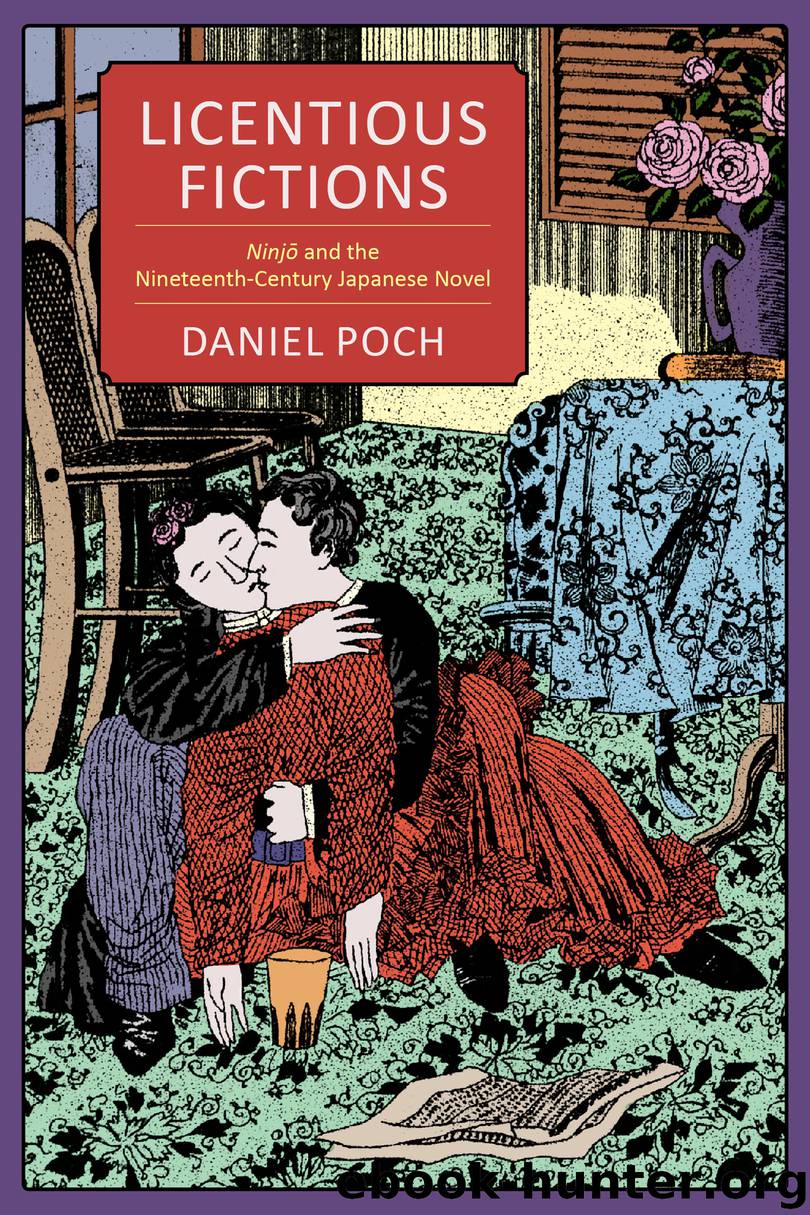Licentious Fictions by Daniel Poch

Author:Daniel Poch
Language: eng
Format: epub
Publisher: Columbia University Press
MIRROR OF MARRIAGE: RADICALIZING THE APORIA
Scholars have rarely discussed Tōsei shosei katagi in connection with Imotose kagami, although the latter can be seen as a sequel to the former.31 Imotose kagami writes a transformation of students of sorts featuring a young male protagonist, Misawa Tatsuzō, who, unlike Komachida, has recently graduated from the university and found a well-paid job in the government bureaucracy. Of greater significance is the fact that the novel focuses, as its title indicates, on marriage, the theme that Tōsei shosei katagi avoided. Shōyō’s preface explicitly reflects on this evolution:
The focus of the novel is on human emotion, and the strongest human emotion is love [ai].… No kind of love [aijō] is stronger than the affection [renjō] between men and women. This is why a love story [jōwa] between a man and a woman must be the backbone of the novel’s plot. However, since the main focus of this novel is on the relationship between husband and wife [imo to se no kōjō] and not unmarried lovers [jōfu jōrō], it greatly differs from the love stories of the Tamenaga school.32
By focusing on the emotions of husband and wife, Imotose kagami takes the wind out of the sails of critics who, like Iwamoto, bemoaned the affinity of Shōyō’s first novel to the ninjōbon. Given that marriage, in contemporary discourse, had become the ideological locus for the formulation of enlightened gender ideals, the new focus of Imotose kagami was part of a maturation process. It could be seen as the fulfillment of the idealist impulse to finally depict civilized love. Imotose kagami also no longer juxtaposes incongruous gesaku formats but is written in a more unified literary style that, while stylistically reminiscent of Bakin’s yomihon, is closer to a Western novel.33 However, the representation of a high-class love again fails, and this radicalizes the aporia between the representation of idealist and realist elements.
At the horizon of Imotose kagami lies the possibility of an enlightened love marriage, between the hero, Misawa, and Oyuki, the educated, beautiful, and exemplary daughter of a high-ranking Meiji bureaucrat. This union is perceived by everybody, including Oyuki’s parents, as ideal, but it fails because Misawa happens to eavesdrop on a conversation in which the potential bride pretends to despise him, although, in truth, she wants to conceal her affection for him. As a consequence, Misawa chooses to marry an attractive, but uneducated and low-class woman, Otsuji, the daughter of a fishmonger, and Oyuki, against her feelings and under pressure from her parents, marries an unworthy social climber and opportunist. Both marriages end unhappily. The primary didactic aim of the novel, repeatedly articulated by the narrator, is to illustrate the pitfalls inherent in these two types of union: “free marriage” (jiyū kekkon) and “forced marriage” (kanshō kekkon), respectively. This intent was not lost on contemporary readers. In his review of the novel, fittingly published in Jogaku zasshi, the young critic Ishibashi Ningetsu (1865–1926) saw the “didactic revelation” of the “two evils” of freedom and parental interference
Download
This site does not store any files on its server. We only index and link to content provided by other sites. Please contact the content providers to delete copyright contents if any and email us, we'll remove relevant links or contents immediately.
| African | Asian |
| Australian & Oceanian | Canadian |
| Caribbean & Latin American | European |
| Jewish | Middle Eastern |
| Russian | United States |
4 3 2 1: A Novel by Paul Auster(11049)
The handmaid's tale by Margaret Atwood(6852)
Giovanni's Room by James Baldwin(5878)
Big Magic: Creative Living Beyond Fear by Elizabeth Gilbert(4723)
Asking the Right Questions: A Guide to Critical Thinking by M. Neil Browne & Stuart M. Keeley(4574)
On Writing A Memoir of the Craft by Stephen King(4213)
Ego Is the Enemy by Ryan Holiday(3991)
Ken Follett - World without end by Ken Follett(3972)
The Body: A Guide for Occupants by Bill Bryson(3801)
Bluets by Maggie Nelson(3710)
Adulting by Kelly Williams Brown(3670)
Guilty Pleasures by Laurell K Hamilton(3586)
Eat That Frog! by Brian Tracy(3514)
White Noise - A Novel by Don DeLillo(3435)
The Poetry of Pablo Neruda by Pablo Neruda(3367)
Alive: The Story of the Andes Survivors by Piers Paul Read(3310)
The Bookshop by Penelope Fitzgerald(3225)
The Book of Joy by Dalai Lama(3217)
Fingerprints of the Gods by Graham Hancock(3212)
